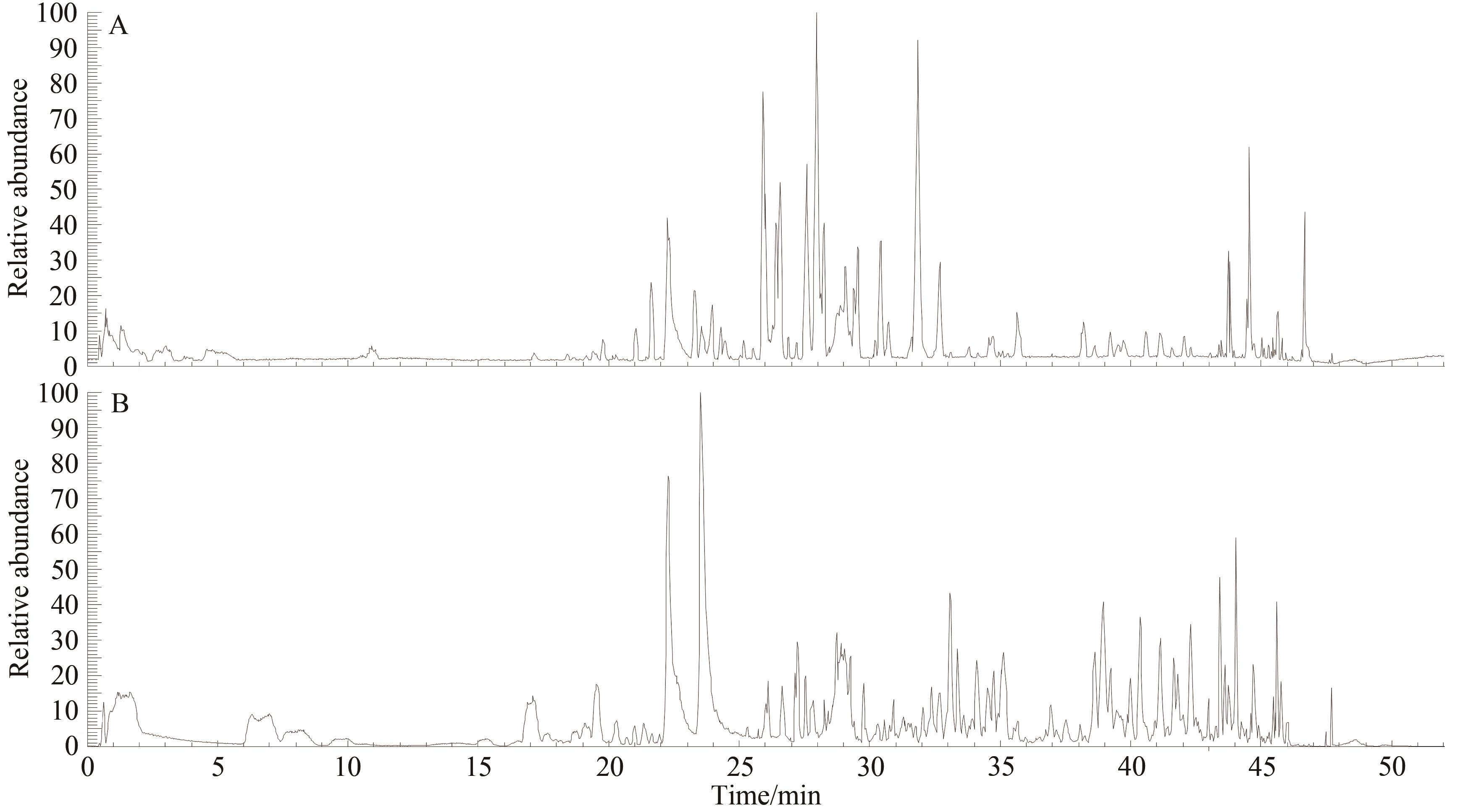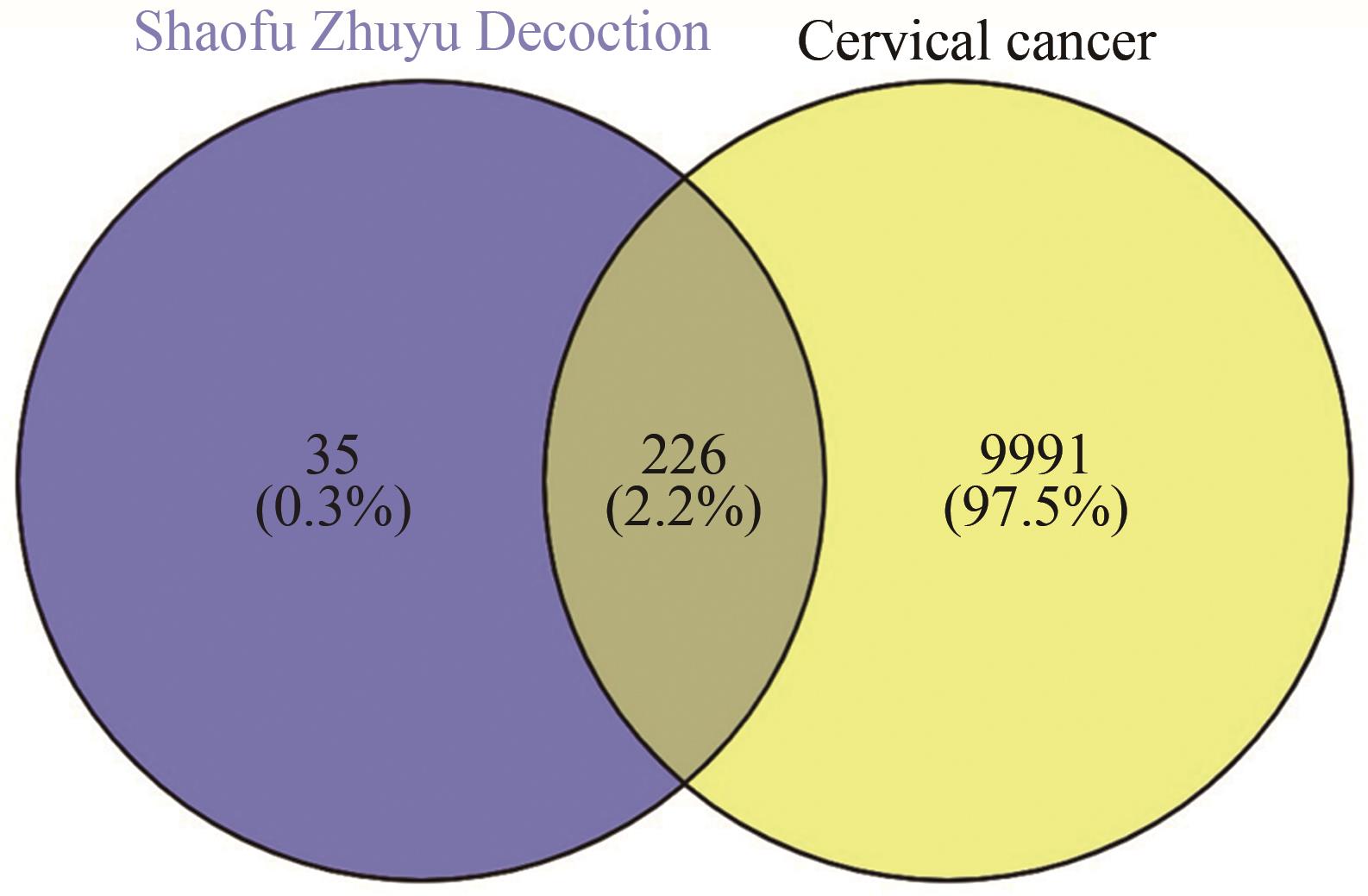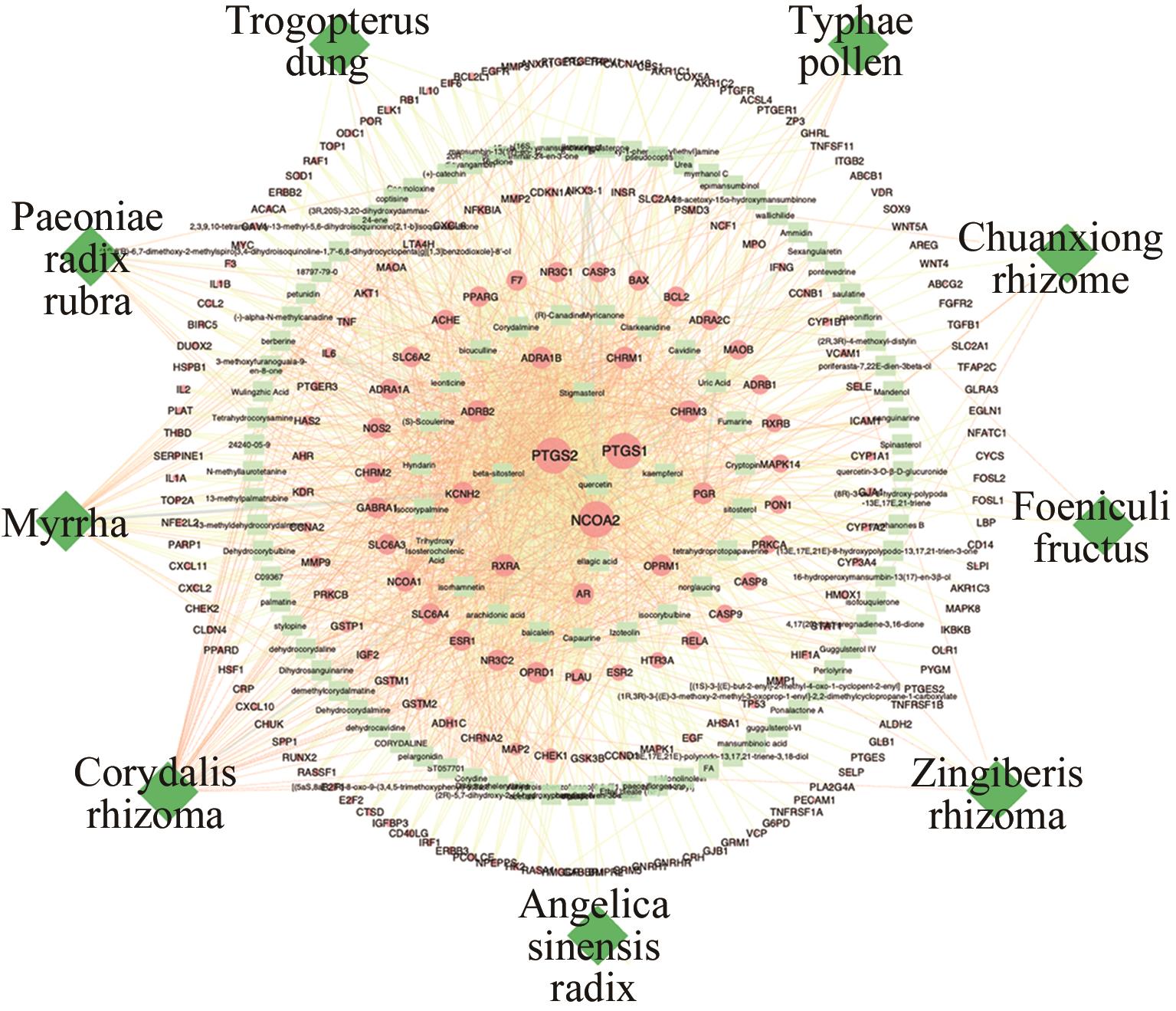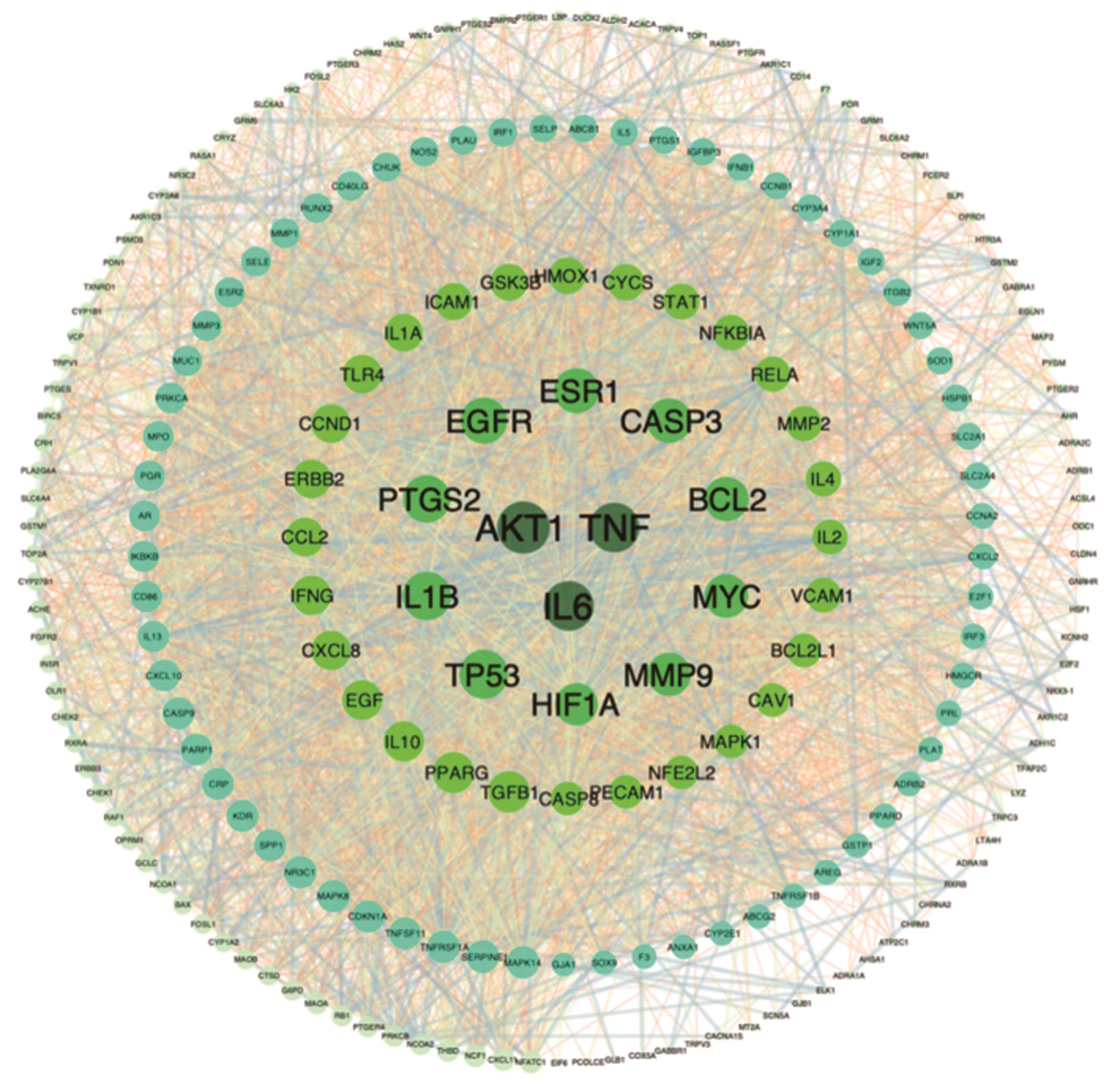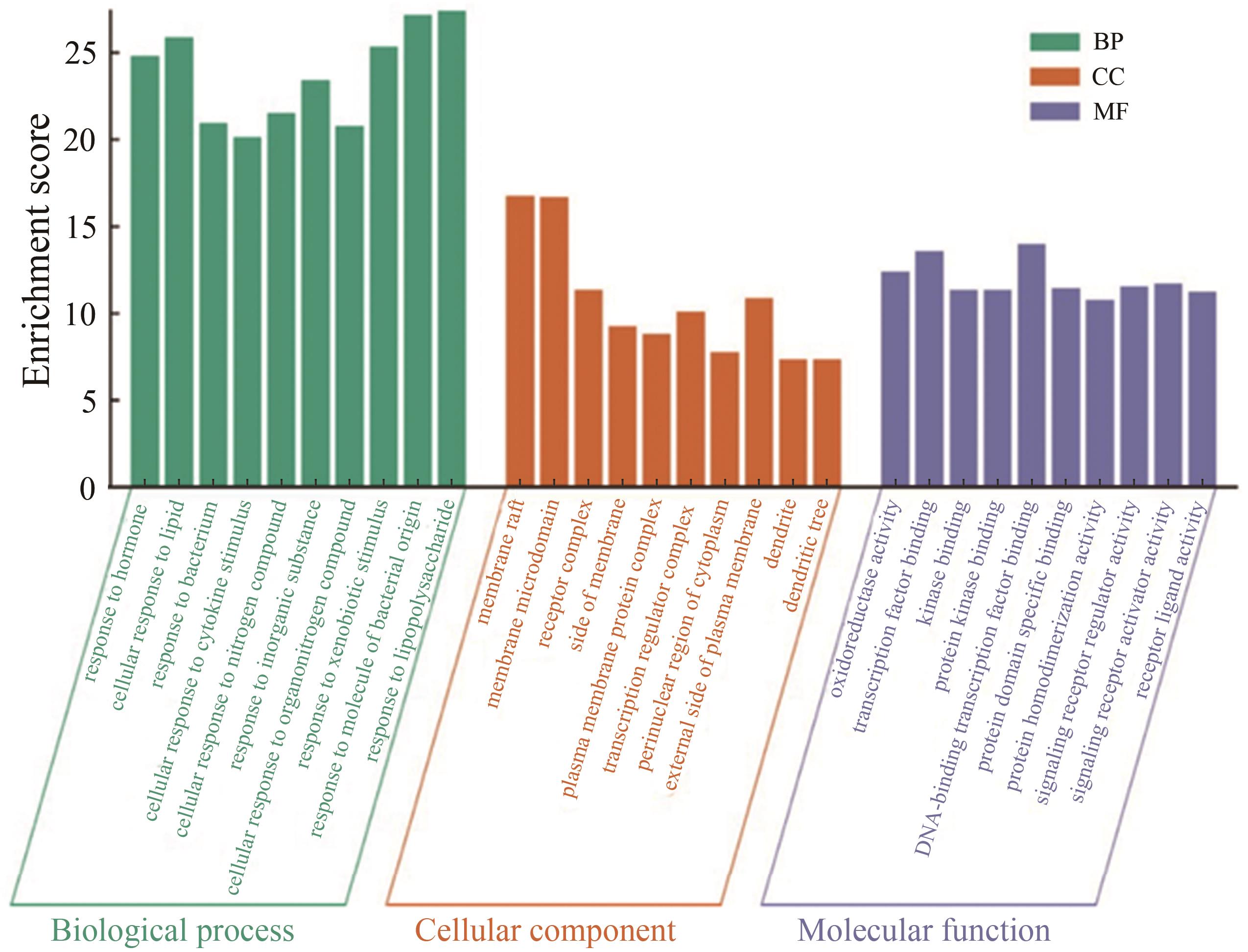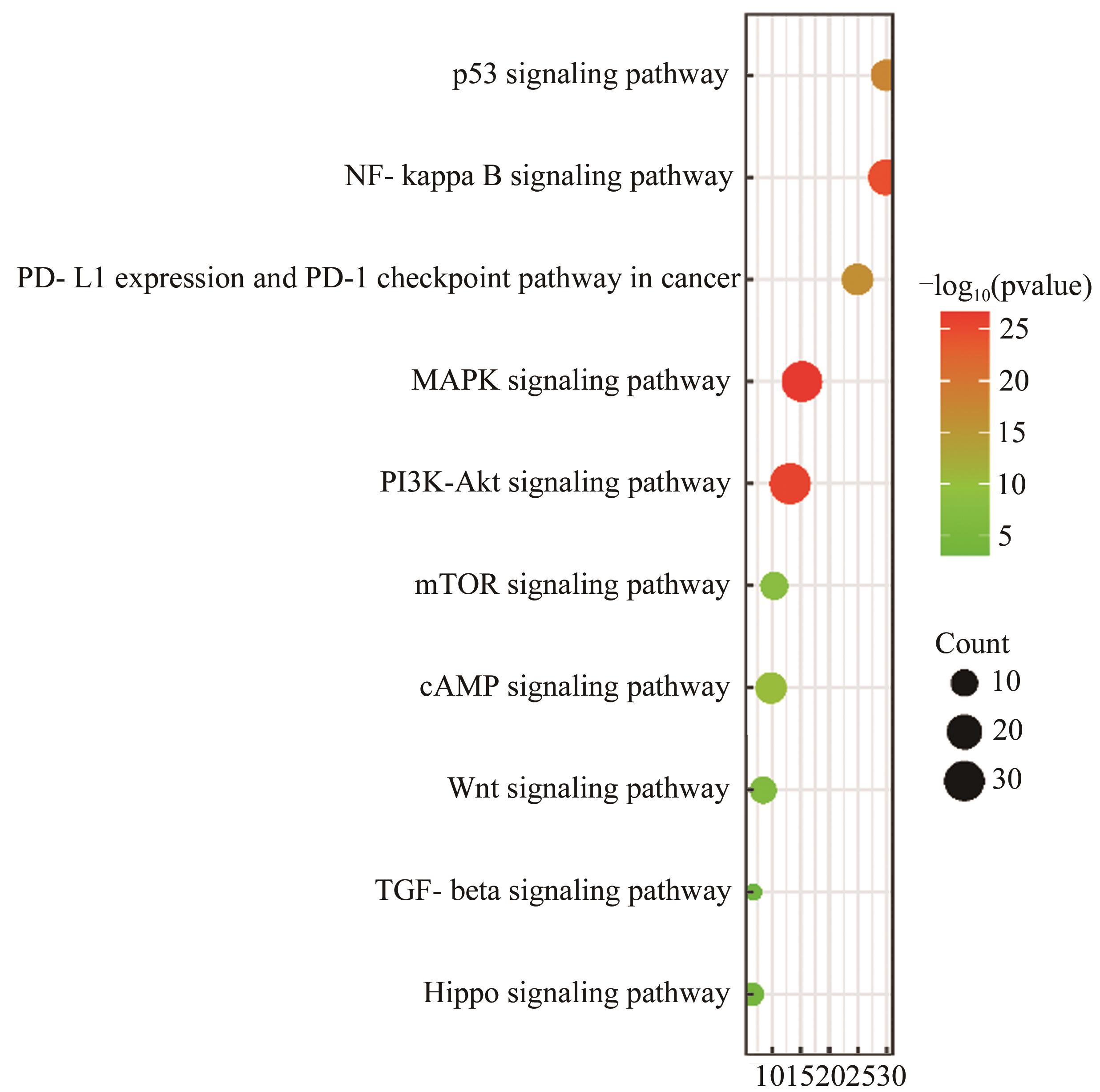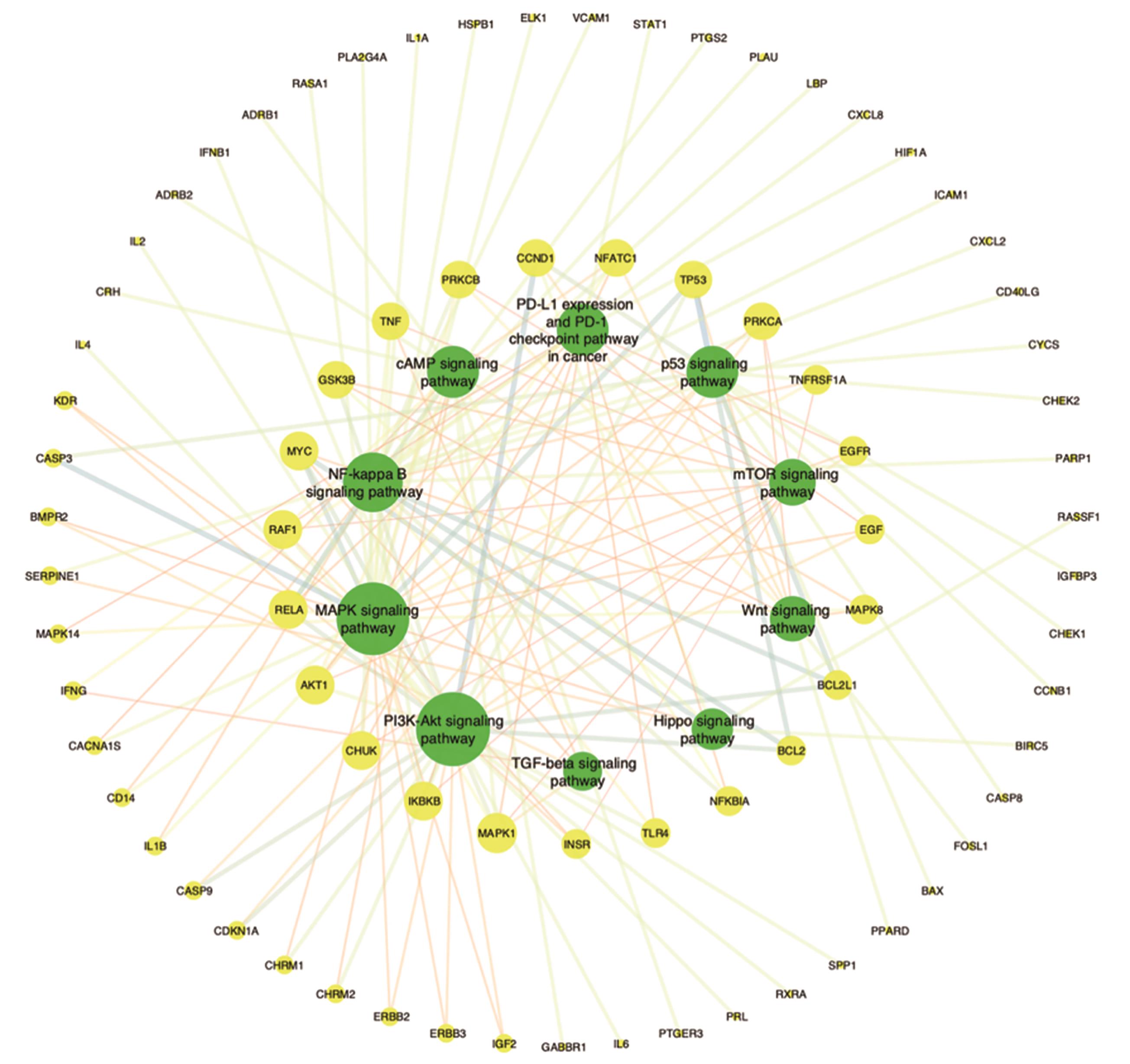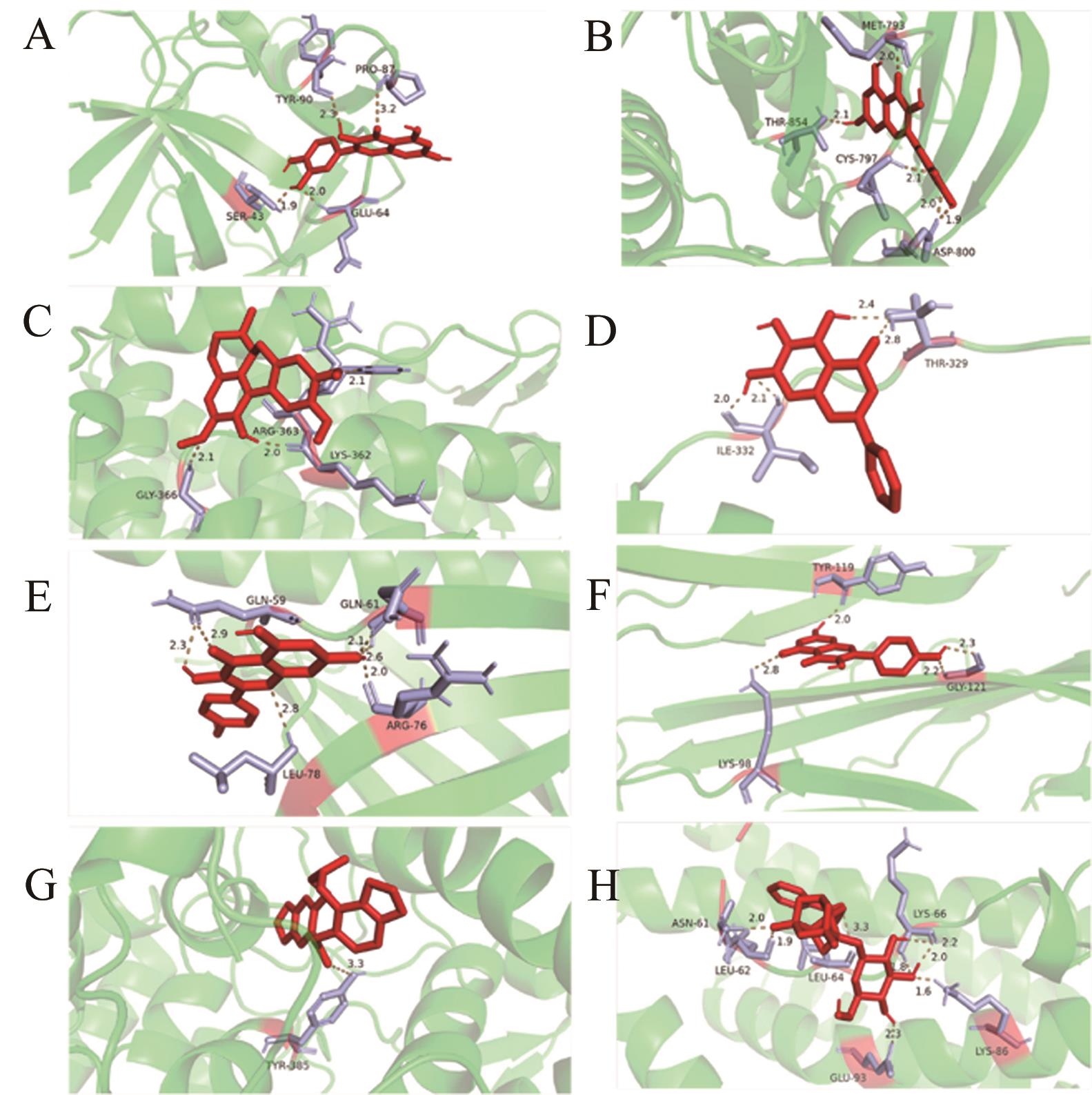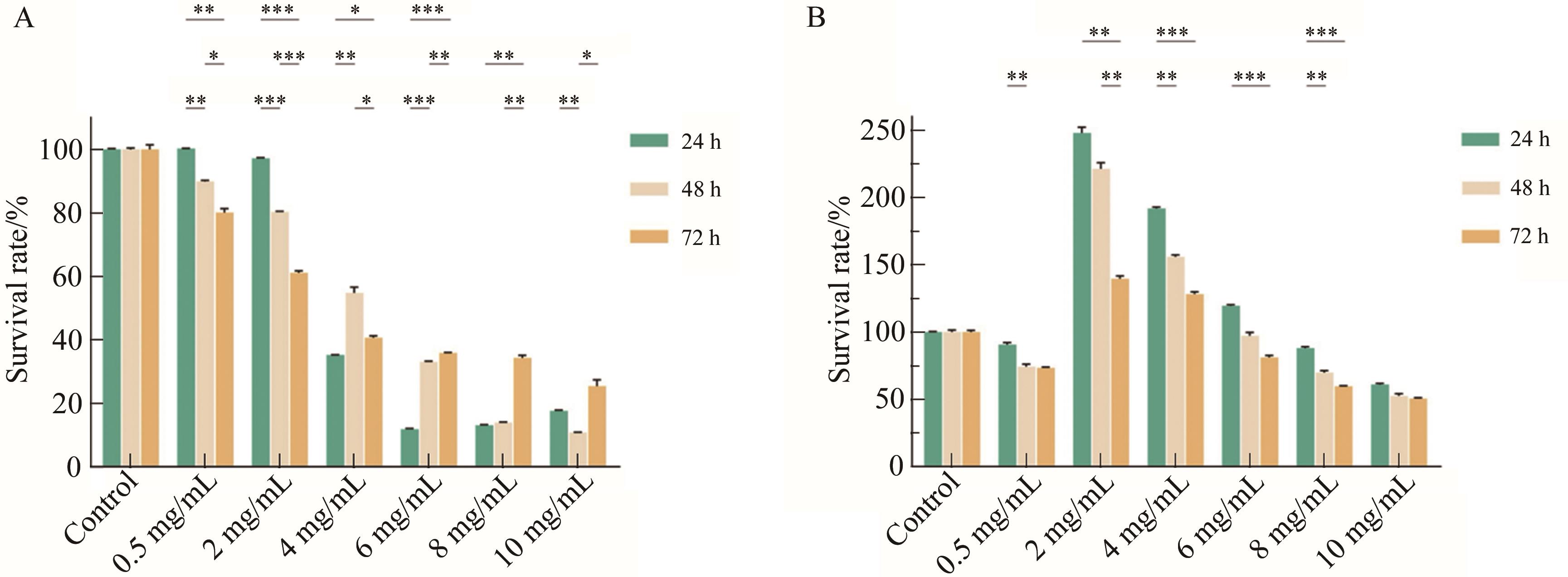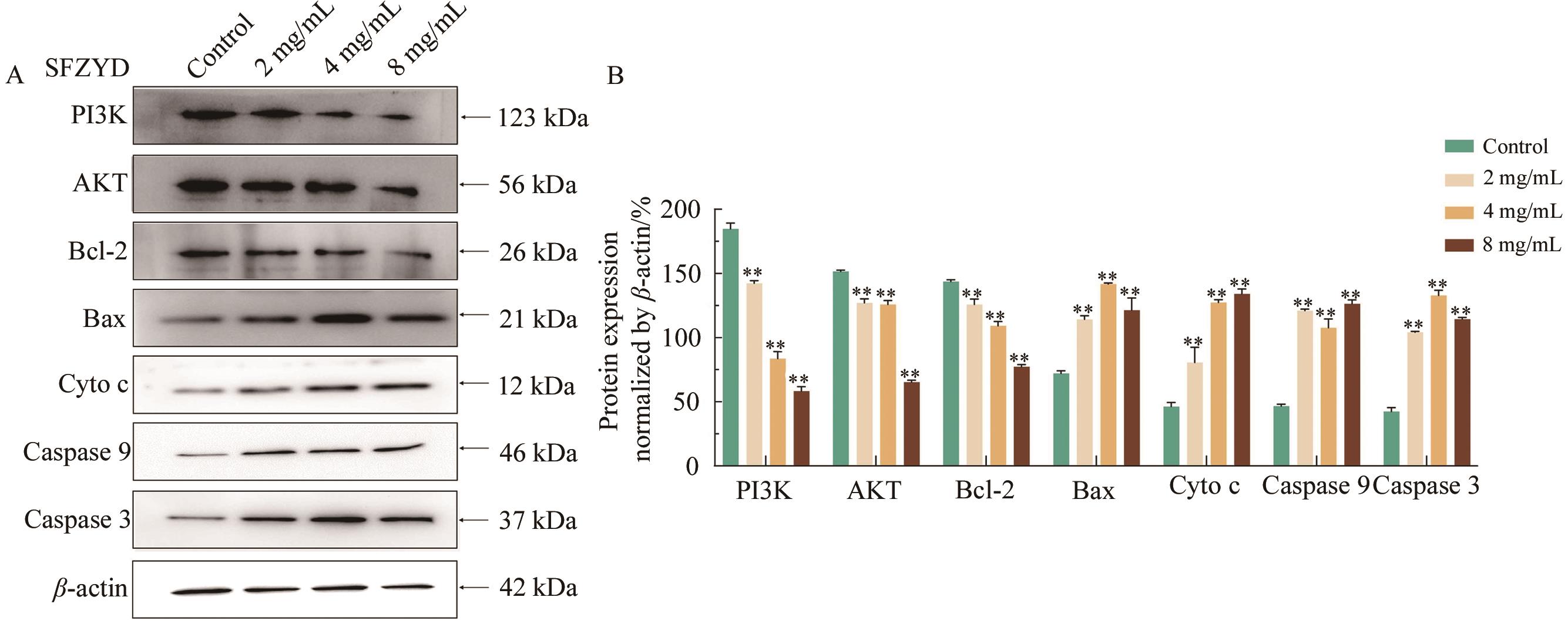
Chinese Journal of Applied Chemistry ›› 2024, Vol. 41 ›› Issue (5): 687-702.DOI: 10.19894/j.issn.1000-0518.230318
• Full Papers • Previous Articles Next Articles
The Anti-Cervical Cancer Mechanism of Shaofu Zhuyu Decoction Based on Liquid Chromatography Mass Spectrometry Combined with Network Pharmacology
Xuan HU1, Tong-Chuan WU1, Xin-Dan AI1, Xing-Yue HE2, Hong-Kang XU1, Fei ZHENG1, Hao YUE1( ), Yu-Lin DAI1(
), Yu-Lin DAI1( )
)
- 1.Jilin Ginseng Academy,Changchun University of Chinese Medicine,Changchun 130117,China
2.School of Rehabilitation Medicine,Changchun University of Chinese Medicine,Changchun 130117,China
-
Received:2023-10-12Accepted:2024-03-09Published:2024-05-01Online:2024-06-03 -
Contact:Hao YUE,Yu-Lin DAI -
About author:daiyl@ccucm.edu.cn
yuehao@ccucm.edu.cn;
-
Supported by:Jilin Scientific and Technological Development Program(20210401065YY)
CLC Number:
Cite this article
Xuan HU, Tong-Chuan WU, Xin-Dan AI, Xing-Yue HE, Hong-Kang XU, Fei ZHENG, Hao YUE, Yu-Lin DAI. The Anti-Cervical Cancer Mechanism of Shaofu Zhuyu Decoction Based on Liquid Chromatography Mass Spectrometry Combined with Network Pharmacology[J]. Chinese Journal of Applied Chemistry, 2024, 41(5): 687-702.
share this article
Add to citation manager EndNote|Ris|BibTeX
URL: http://yyhx.ciac.jl.cn/EN/10.19894/j.issn.1000-0518.230318
| Mol ID | Compounds | OB/% | DL | Origin |
|---|---|---|---|---|
| MOL001918 | Paeoniflorgenone | 87.59 | 0.37 | Paeoniae radix rubra |
| MOL001925 | Paeoniflorin_qt | 68.18 | 0.40 | Paeoniae radix rubra |
| MOL007016 | Paeoniflorigenone | 65.33 | 0.37 | Paeoniae radix rubra |
| MOL006996 | 1-o-beta-d-Glucopyranosylpaeonisuffrone_qt | 65.08 | 0.35 | Paeoniae radix rubra |
| MOL007022 | EvofolinB | 64.74 | 0.22 | Paeoniae radix rubra |
| MOL007018 | 9-Ethyl-neo-paeoniaflorin A_qt | 64.42 | 0.30 | Paeoniae radix rubra |
| MOL006992 | (2R,3R)-4-Methoxyl-distylin | 59.98 | 0.30 | Paeoniae radix rubra |
| MOL007008 | 4-Ethyl-paeoniflorin_qt | 56.87 | 0.44 | Paeoniae radix rubra |
| MOL007012 | 4-o-Methyl-paeoniflorin_qt | 56.7 | 0.43 | Paeoniae radix rubra |
| MOL000492 | (+)-Catechin | 54.83 | 0.24 | Paeoniae radix rubra |
| MOL000433 | FA | 68.96 | 0.71 | Chuanxiong rhizome |
| MOL002140 | Perlolyrine | 65.95 | 0.27 | Chuanxiong rhizome |
| MOL002151 | Senkyunone | 47.66 | 0.24 | Chuanxiong rhizome |
| MOL002157 | Wallichilide | 42.31 | 0.71 | Chuanxiong rhizome |
| MOL001494 | Mandenol | 42.00 | 0.19 | Chuanxiong rhizome |
| MOL002135 | Myricanone | 40.60 | 0.51 | Chuanxiong rhizome |
| MOL000359 | Sitosterol | 36.91 | 0.75 | Chuanxiong rhizome, Zingiberis rhizoma |
| MOL002514 | Sexangularetin | 62.86 | 0.30 | Zingiberis rhizoma |
| MOL002501 | [(1S)-3-[(E)-but-2-enyl]-2-methyl-4-oxo-1-cyclopent-2-enyl] (1R,3R)-3-[(E)-3-methoxy-2-methyl-3-oxoprop-1-enyl]-2,2-dimethylcyclopropane-1-carboxylate | 62.52 | 0.31 | Zingiberis rhizoma |
| MOL002464 | 1-Monolinolein | 37.18 | 0.30 | Zingiberis rhizoma |
| MOL000358 | beta-Sitosterol | 36.91 | 0.75 | Zingiberis rhizoma, Angelica sinensis radix, Foeniculi fructus, Typhae pollen |
| MOL000979 | 2-Methoxyfuranoguaia-9-ene-8-one | 66.18 | 0.18 | Myrrha |
| MOL001033 | Diayangambin | 63.84 | 0.81 | Myrrha |
| MOL001031 | Epimansumbinol | 61.81 | 0.40 | Myrrha |
| MOL001131 | Phellamurin_qt | 56.6 | 0.39 | Myrrha |
| MOL001009 | Guggulsterol-VI | 54.72 | 0.43 | Myrrha |
| MOL000988 | 4,17(20)-(cis)-Pregnadiene-3,16-dione | 51.42 | 0.48 | Myrrha |
| MOL001013 | Mansumbinoic acid | 48.10 | 0.32 | Myrrha |
| MOL000098 | Quercetin | 46.43 | 0.28 | Myrrha, Typhae pollen |
| MOL001028 | (8R)-3-oxo-8-Hydroxy-polypoda -13E,17E,21-triene | 44.83 | 0.59 | Myrrha |
| MOL001088 | 1α-Acetoxy-9,19-cyclolanost-24-en-3β-ol | 44.40 | 0.78 | Myrrha |
| MOL006115 | Kaempferol-3-O-α-L-rhamnosyl(1→2)-β-D-glucoside_qt | 62.87 | 0.24 | Typhae pollen |
| MOL000354 | Isorhamnetin | 49.60 | 0.31 | Typhae pollen |
| MOL001439 | Arachidonic acid | 45.57 | 0.20 | Typhae pollen |
| MOL001040 | (2R)-5,7-Dihydroxy-2-(4-hydroxyphenyl)chroman-4-one | 42.36 | 0.21 | Typhae pollen |
| MOL000422 | Kaempferol | 41.88 | 0.24 | Typhae pollen |
| MOL006111 | Testosterone palmitate | 34.14 | 0.71 | Typhae pollen |
| MOL000449 | Stigmasterol | 43.83 | 0.76 | Angelica sinensis radix, Foeniculi fructus |
| MOL000254 | Eugenol | 56.24 | 0.04 | Cinnamomi cortex |
| MOL000118 | L-alpha-terpineol | 48.80 | 0.03 | Cinnamomi cortex |
| MOL000198 | (R)-Linalool | 39.80 | 0.02 | Cinnamomi cortex |
| MOL000475 | Anethole | 32.49 | 0.03 | Cinnamomi cortex |
| MOL000991 | Cinnamaldehyde | 31.99 | 0.02 | Cinnamomi cortex |
| MOL002380 | cis-Anethol | 30.86 | 0.03 | Cinnamomi cortex |
| MOL000704 | Styrene | 29.55 | 0.01 | Cinnamomi cortex |
| MOL000431 | Coumarin | 29.17 | 0.04 | Cinnamomi cortex |
| MOL000250 | cis-Cinnamaldehyde | 27.21 | 0.02 | Cinnamomi cortex |
| MOL000024 | alpha-Humulene | 22.98 | 0.06 | Cinnamomi cortex |
| MOL001941 | Ammidin | 34.55 | 0.22 | Foeniculi fructus |
| MOL004193 | Clarkeanidine | 86.65 | 0.54 | Corydalis rhizoma |
| MOL001460 | Cryptopin | 78.74 | 0.72 | Corydalis rhizoma |
| MOL004234 | 2,3,9,10-Tetramethoxy-13-methyl-5,6-dihydroisoquinolino[2,1-b]isoquinolin-8-one | 76.77 | 0.73 | Corydalis rhizoma |
| MOL004071 | Hyndarin | 73.94 | 0.64 | Corydalis rhizoma |
| MOL000791 | Bicuculline | 69.67 | 0.88 | Corydalis rhizoma |
| MOL004195 | CORYDALINE | 65.84 | 0.68 | Corydalis rhizoma |
| MOL000785 | Palmatine | 64.60 | 0.65 | Corydalis rhizoma |
| MOL004191 | Capaurine | 62.91 | 0.69 | Corydalis rhizoma |
| MOL004200 | Methyl-[2-(3,4,6,7-tetramethoxy-1-phenanthryl)ethyl]amine | 61.15 | 0.44 | Corydalis rhizoma |
| MOL001463 | Dihydrosanguinarine | 59.31 | 0.86 | Corydalis rhizoma |
| WLZ000001 | Ponalactone A | - | - | Trogopterus dung |
| WLZ000002 | Uric acid | - | - | Trogopterus dung |
| WLZ000003 | Wulingzhic acid | - | - | Trogopterus dung |
| WLZ000004 | Japondipsaponin E1 | - | - | Trogopterus dung |
| WLZ000005 | Urea | - | - | Trogopterus dung |
| WLZ000006 | Trihydroxy isosterocholenic acid | - | - | Trogopterus dung |
Table 1 Candidate active ingredients of Shaofu Zhuyu Decoction
| Mol ID | Compounds | OB/% | DL | Origin |
|---|---|---|---|---|
| MOL001918 | Paeoniflorgenone | 87.59 | 0.37 | Paeoniae radix rubra |
| MOL001925 | Paeoniflorin_qt | 68.18 | 0.40 | Paeoniae radix rubra |
| MOL007016 | Paeoniflorigenone | 65.33 | 0.37 | Paeoniae radix rubra |
| MOL006996 | 1-o-beta-d-Glucopyranosylpaeonisuffrone_qt | 65.08 | 0.35 | Paeoniae radix rubra |
| MOL007022 | EvofolinB | 64.74 | 0.22 | Paeoniae radix rubra |
| MOL007018 | 9-Ethyl-neo-paeoniaflorin A_qt | 64.42 | 0.30 | Paeoniae radix rubra |
| MOL006992 | (2R,3R)-4-Methoxyl-distylin | 59.98 | 0.30 | Paeoniae radix rubra |
| MOL007008 | 4-Ethyl-paeoniflorin_qt | 56.87 | 0.44 | Paeoniae radix rubra |
| MOL007012 | 4-o-Methyl-paeoniflorin_qt | 56.7 | 0.43 | Paeoniae radix rubra |
| MOL000492 | (+)-Catechin | 54.83 | 0.24 | Paeoniae radix rubra |
| MOL000433 | FA | 68.96 | 0.71 | Chuanxiong rhizome |
| MOL002140 | Perlolyrine | 65.95 | 0.27 | Chuanxiong rhizome |
| MOL002151 | Senkyunone | 47.66 | 0.24 | Chuanxiong rhizome |
| MOL002157 | Wallichilide | 42.31 | 0.71 | Chuanxiong rhizome |
| MOL001494 | Mandenol | 42.00 | 0.19 | Chuanxiong rhizome |
| MOL002135 | Myricanone | 40.60 | 0.51 | Chuanxiong rhizome |
| MOL000359 | Sitosterol | 36.91 | 0.75 | Chuanxiong rhizome, Zingiberis rhizoma |
| MOL002514 | Sexangularetin | 62.86 | 0.30 | Zingiberis rhizoma |
| MOL002501 | [(1S)-3-[(E)-but-2-enyl]-2-methyl-4-oxo-1-cyclopent-2-enyl] (1R,3R)-3-[(E)-3-methoxy-2-methyl-3-oxoprop-1-enyl]-2,2-dimethylcyclopropane-1-carboxylate | 62.52 | 0.31 | Zingiberis rhizoma |
| MOL002464 | 1-Monolinolein | 37.18 | 0.30 | Zingiberis rhizoma |
| MOL000358 | beta-Sitosterol | 36.91 | 0.75 | Zingiberis rhizoma, Angelica sinensis radix, Foeniculi fructus, Typhae pollen |
| MOL000979 | 2-Methoxyfuranoguaia-9-ene-8-one | 66.18 | 0.18 | Myrrha |
| MOL001033 | Diayangambin | 63.84 | 0.81 | Myrrha |
| MOL001031 | Epimansumbinol | 61.81 | 0.40 | Myrrha |
| MOL001131 | Phellamurin_qt | 56.6 | 0.39 | Myrrha |
| MOL001009 | Guggulsterol-VI | 54.72 | 0.43 | Myrrha |
| MOL000988 | 4,17(20)-(cis)-Pregnadiene-3,16-dione | 51.42 | 0.48 | Myrrha |
| MOL001013 | Mansumbinoic acid | 48.10 | 0.32 | Myrrha |
| MOL000098 | Quercetin | 46.43 | 0.28 | Myrrha, Typhae pollen |
| MOL001028 | (8R)-3-oxo-8-Hydroxy-polypoda -13E,17E,21-triene | 44.83 | 0.59 | Myrrha |
| MOL001088 | 1α-Acetoxy-9,19-cyclolanost-24-en-3β-ol | 44.40 | 0.78 | Myrrha |
| MOL006115 | Kaempferol-3-O-α-L-rhamnosyl(1→2)-β-D-glucoside_qt | 62.87 | 0.24 | Typhae pollen |
| MOL000354 | Isorhamnetin | 49.60 | 0.31 | Typhae pollen |
| MOL001439 | Arachidonic acid | 45.57 | 0.20 | Typhae pollen |
| MOL001040 | (2R)-5,7-Dihydroxy-2-(4-hydroxyphenyl)chroman-4-one | 42.36 | 0.21 | Typhae pollen |
| MOL000422 | Kaempferol | 41.88 | 0.24 | Typhae pollen |
| MOL006111 | Testosterone palmitate | 34.14 | 0.71 | Typhae pollen |
| MOL000449 | Stigmasterol | 43.83 | 0.76 | Angelica sinensis radix, Foeniculi fructus |
| MOL000254 | Eugenol | 56.24 | 0.04 | Cinnamomi cortex |
| MOL000118 | L-alpha-terpineol | 48.80 | 0.03 | Cinnamomi cortex |
| MOL000198 | (R)-Linalool | 39.80 | 0.02 | Cinnamomi cortex |
| MOL000475 | Anethole | 32.49 | 0.03 | Cinnamomi cortex |
| MOL000991 | Cinnamaldehyde | 31.99 | 0.02 | Cinnamomi cortex |
| MOL002380 | cis-Anethol | 30.86 | 0.03 | Cinnamomi cortex |
| MOL000704 | Styrene | 29.55 | 0.01 | Cinnamomi cortex |
| MOL000431 | Coumarin | 29.17 | 0.04 | Cinnamomi cortex |
| MOL000250 | cis-Cinnamaldehyde | 27.21 | 0.02 | Cinnamomi cortex |
| MOL000024 | alpha-Humulene | 22.98 | 0.06 | Cinnamomi cortex |
| MOL001941 | Ammidin | 34.55 | 0.22 | Foeniculi fructus |
| MOL004193 | Clarkeanidine | 86.65 | 0.54 | Corydalis rhizoma |
| MOL001460 | Cryptopin | 78.74 | 0.72 | Corydalis rhizoma |
| MOL004234 | 2,3,9,10-Tetramethoxy-13-methyl-5,6-dihydroisoquinolino[2,1-b]isoquinolin-8-one | 76.77 | 0.73 | Corydalis rhizoma |
| MOL004071 | Hyndarin | 73.94 | 0.64 | Corydalis rhizoma |
| MOL000791 | Bicuculline | 69.67 | 0.88 | Corydalis rhizoma |
| MOL004195 | CORYDALINE | 65.84 | 0.68 | Corydalis rhizoma |
| MOL000785 | Palmatine | 64.60 | 0.65 | Corydalis rhizoma |
| MOL004191 | Capaurine | 62.91 | 0.69 | Corydalis rhizoma |
| MOL004200 | Methyl-[2-(3,4,6,7-tetramethoxy-1-phenanthryl)ethyl]amine | 61.15 | 0.44 | Corydalis rhizoma |
| MOL001463 | Dihydrosanguinarine | 59.31 | 0.86 | Corydalis rhizoma |
| WLZ000001 | Ponalactone A | - | - | Trogopterus dung |
| WLZ000002 | Uric acid | - | - | Trogopterus dung |
| WLZ000003 | Wulingzhic acid | - | - | Trogopterus dung |
| WLZ000004 | Japondipsaponin E1 | - | - | Trogopterus dung |
| WLZ000005 | Urea | - | - | Trogopterus dung |
| WLZ000006 | Trihydroxy isosterocholenic acid | - | - | Trogopterus dung |
| Compounds | Degree | Betweenness centrality | Closeness centrality | Structure |
|---|---|---|---|---|
| Quercetin | 351 | 0.435 155 | 0.489 569 |  |
| beta-Sitosterol | 144 | 0.042 876 | 0.389 812 | 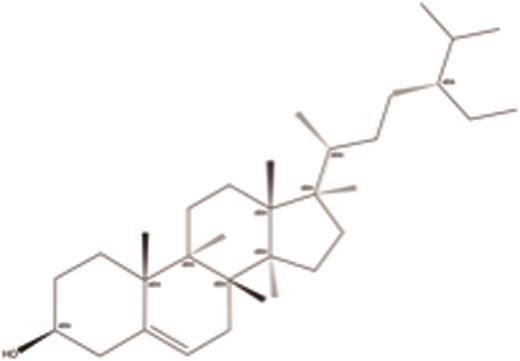 |
| Stigmasterol | 115 | 0.034 907 | 0.388 093 | 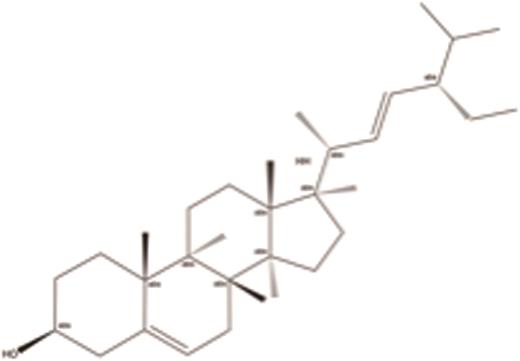 |
| Kaempferol | 45 | 0.074 389 | 0.399 546 | 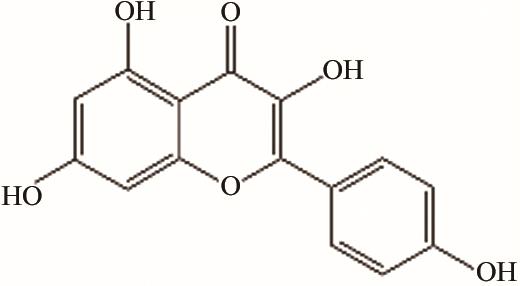 |
| Ellagic acid | 30 | 0.010 948 | 0.346 798 | 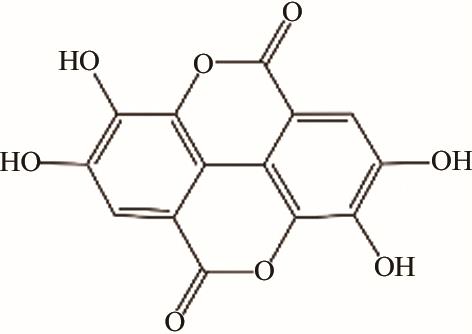 |
| Eugenol | 29 | 0.056 086 | 0.360 287 | 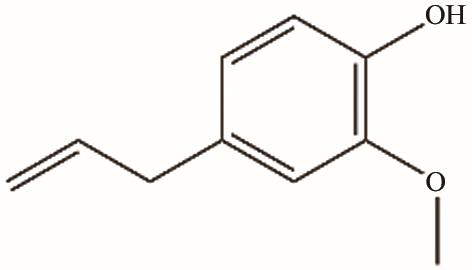 |
| Arachidonic acid | 23 | 0.063 158 | 0.350 947 | 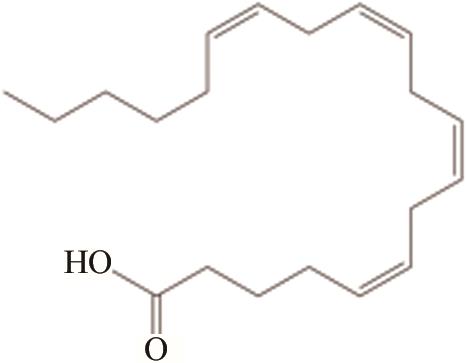 |
| Baicalein | 23 | 0.041 211 | 0.367 816 | 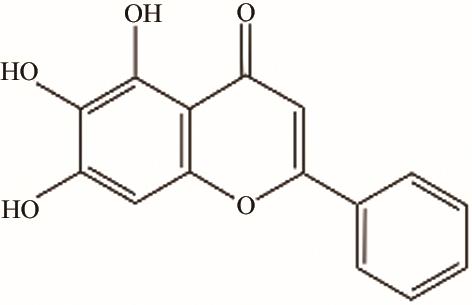 |
| Isorhamnetin | 22 | 0.025 932 | 0.368 586 | 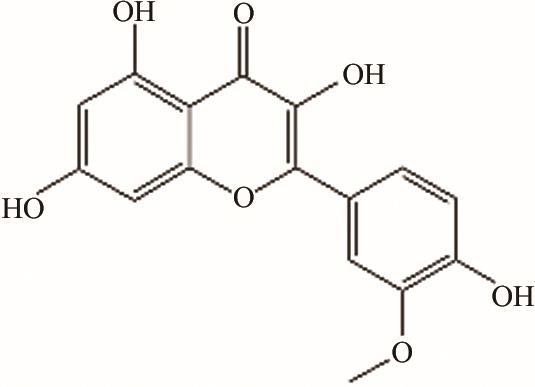 |
| Trihydroxy isosterocholenic acid | 21 | 0.074 025 | 0.374 070 | 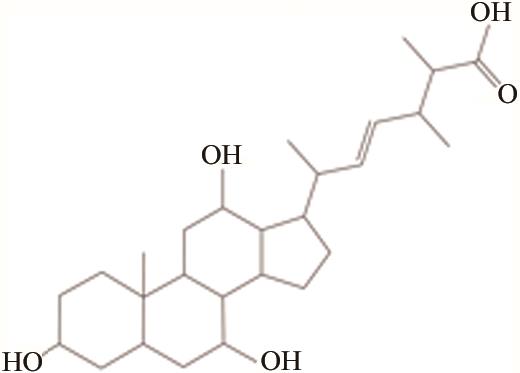 |
Table 2 Topological parameters of the nodes of active components in Shaofu Zhuyu Decoction
| Compounds | Degree | Betweenness centrality | Closeness centrality | Structure |
|---|---|---|---|---|
| Quercetin | 351 | 0.435 155 | 0.489 569 |  |
| beta-Sitosterol | 144 | 0.042 876 | 0.389 812 |  |
| Stigmasterol | 115 | 0.034 907 | 0.388 093 |  |
| Kaempferol | 45 | 0.074 389 | 0.399 546 |  |
| Ellagic acid | 30 | 0.010 948 | 0.346 798 |  |
| Eugenol | 29 | 0.056 086 | 0.360 287 |  |
| Arachidonic acid | 23 | 0.063 158 | 0.350 947 |  |
| Baicalein | 23 | 0.041 211 | 0.367 816 |  |
| Isorhamnetin | 22 | 0.025 932 | 0.368 586 |  |
| Trihydroxy isosterocholenic acid | 21 | 0.074 025 | 0.374 070 |  |
| Genes | Degree | Betweenness centrality | Closeness centrality |
|---|---|---|---|
| PTGS2 | 91 | 0.170 709 83 | 0.495 774 65 |
| PTGS1 | 76 | 0.102 475 29 | 0.466 843 50 |
| NCOA2 | 58 | 0.052 615 02 | 0.399 092 97 |
| RXRA | 50 | 0.033 608 03 | 0.395 505 62 |
| KCNH2 | 48 | 0.024 529 62 | 0.391 111 11 |
| ADRB2 | 47 | 0.021 468 11 | 0.388 520 97 |
| CHRM1 | 47 | 0.011 673 96 | 0.333 333 33 |
| CHRM3 | 46 | 0.007 195 67 | 0.317 689 53 |
| ADRA1B | 45 | 0.009 294 5 | 0.330 827 07 |
| PGR | 39 | 0.047 171 16 | 0.344 422 70 |
Table 3 Topological parameters of the nodes of therapeutic target
| Genes | Degree | Betweenness centrality | Closeness centrality |
|---|---|---|---|
| PTGS2 | 91 | 0.170 709 83 | 0.495 774 65 |
| PTGS1 | 76 | 0.102 475 29 | 0.466 843 50 |
| NCOA2 | 58 | 0.052 615 02 | 0.399 092 97 |
| RXRA | 50 | 0.033 608 03 | 0.395 505 62 |
| KCNH2 | 48 | 0.024 529 62 | 0.391 111 11 |
| ADRB2 | 47 | 0.021 468 11 | 0.388 520 97 |
| CHRM1 | 47 | 0.011 673 96 | 0.333 333 33 |
| CHRM3 | 46 | 0.007 195 67 | 0.317 689 53 |
| ADRA1B | 45 | 0.009 294 5 | 0.330 827 07 |
| PGR | 39 | 0.047 171 16 | 0.344 422 70 |
| Gene targets | Small molecule compounds | PDB ID | Binding energy/(kJ·mol-1) |
|---|---|---|---|
| IL6 | quercetin | 1ALU | -24.48 |
| IL6 | paeoniflorin | 1ALU | -26.48 |
| TNF | quercetin | 1A8M | -20.13 |
| TNF | paeoniflorin | 1A8M | -14.77 |
| TNF | kaempferol | 1A8M | -21.51 |
| AKT1 | quercetin | 1UNQ | -24.39 |
| AKT1 | baicalein | 1UNQ | -23.93 |
| AKT1 | kaempferol | 1UNQ | -24.56 |
| TP53 | quercetin | 1AIE | -24.56 |
| TP53 | baicalein | 1AIE | -24.85 |
| IL1B | quercetin | 1L2H | -18.58 |
| PTGS2 | myricanone | 5F1A | -29.29 |
| PTGS2 | 24240-05-9 | 5F1A | -29.16 |
| PTGS2 | fumarine | 5F1A | -30.79 |
| PTGS2 | myrrhanol C | 5F1A | -28.20 |
| PTGS2 | myrrhanones B | 5F1A | -24.18 |
| PTGS2 | 15α-hydroxymansumbinone | 5F1A | -32.17 |
| PTGS2 | 3-methoxyfuranoguaia-9- en-8-one | 5F1A | -24.31 |
| ESR1 | ST057701 | 1L2I | -28.87 |
| EGFR | quercetin | 4I22 | -29.62 |
Table 4 Molecular docking of active components of Shaofu Zhuyu Decoction to key targets
| Gene targets | Small molecule compounds | PDB ID | Binding energy/(kJ·mol-1) |
|---|---|---|---|
| IL6 | quercetin | 1ALU | -24.48 |
| IL6 | paeoniflorin | 1ALU | -26.48 |
| TNF | quercetin | 1A8M | -20.13 |
| TNF | paeoniflorin | 1A8M | -14.77 |
| TNF | kaempferol | 1A8M | -21.51 |
| AKT1 | quercetin | 1UNQ | -24.39 |
| AKT1 | baicalein | 1UNQ | -23.93 |
| AKT1 | kaempferol | 1UNQ | -24.56 |
| TP53 | quercetin | 1AIE | -24.56 |
| TP53 | baicalein | 1AIE | -24.85 |
| IL1B | quercetin | 1L2H | -18.58 |
| PTGS2 | myricanone | 5F1A | -29.29 |
| PTGS2 | 24240-05-9 | 5F1A | -29.16 |
| PTGS2 | fumarine | 5F1A | -30.79 |
| PTGS2 | myrrhanol C | 5F1A | -28.20 |
| PTGS2 | myrrhanones B | 5F1A | -24.18 |
| PTGS2 | 15α-hydroxymansumbinone | 5F1A | -32.17 |
| PTGS2 | 3-methoxyfuranoguaia-9- en-8-one | 5F1A | -24.31 |
| ESR1 | ST057701 | 1L2I | -28.87 |
| EGFR | quercetin | 4I22 | -29.62 |
| 1 | 王宁, 吴修红, 蒋志恒, 等. 少腹逐瘀汤对寒凝血瘀型内异症大鼠模型腹腔液水通道蛋白影响研究[J]. 时珍国医国药, 2021, 32(8): 1840-1843. |
| WANG N, WU X H, JIANG Z H, et al. Study on the effect of Shaofu Zhuyu Decoction on hydro-channel. protein in abdominal cavity fluid in rats with internal disease caused by cold coagulation and blood stasis[J]. Pharmacol Clin Chin Mater Med, 2021, 32(8): 1840-1843. | |
| 2 | 吉秀家, 张小花, 黄灿灿, 等. 少腹逐瘀汤调控PTEN/Akt/mTOR信号通路减轻子宫内膜异位症纤维化[J]. 中国中药杂志, 2023, 48(12): 3207-3214. |
| JI X J, ZHANG X H, HUANG C C, et al. Shaofu Zhuyu Decoction attenuates fibrosis in endometriosis. through regulating PTEN/Akt/mTOR signaling pathway[J]. China J Chin Mater Med, 2023, 48(12): 3207-3214. | |
| 3 | 陈元欢, 毛海燕, 武权生, 等. 基于MSK1/2探讨少腹逐瘀汤治疗子宫内膜异位症痛经寒凝血瘀证的作用机制[J]. 中国中药杂志, 2022, 47(17): 4674-4681. |
| CHEN Y H, MAO H Y, WU Q S, et al. Mechanism of Shaofu Zhuyu Decoction in treatment of endometriosis-associated dysmenorrhea with syndrome of cold coagulation and blood stasis based on MSK1/2[J]. China J Chin Mater Med, 2022, 47(17): 4674-4681. | |
| 4 | 张小玲, 张诗军, 徐成康. 加味少腹逐瘀汤联合灸法治疗原发性痛经55例[J]. 中国实验方剂学杂志, 2014, 20(16): 192-195. |
| ZHANG X L, ZHANG S J, XU C K. Jiawei Shaofu Zhuyu Decoction combined with moxibustion therapy in treating primary dysmenorrhea 55 cases[J]. Chin J Exp Tradit Med Formulae, 2014, 20(16): 192-195. | |
| 5 | MAO Y, SUN J, WANG Z, et al. Combining transcriptomic analysis and network pharmacology to explore the mechanism by which Shaofu Zhuyu Decoction improves diabetes mellitus erectile dysfunction[J]. Phytomedicine, 2023, 119: 155006. |
| 6 | LEE H, CHOI T Y, MYUNG C S, et al. Herbal medicine Shaofu Zhuyu Decoction for primary dysmenorrhea: a systematic review protocol[J]. Syst Rev, 2016, 5(1): 9. |
| 7 | 刘静, 仝伟伟, 孙俊杰, 等. STAT3和CAC1与G6PD蛋白在宫颈癌患者癌组织中的表达及其与高危型HPV感染的关系[J]. 中华医院感染学杂志, 2023(20): 3113-3116. |
| LIU J, TONG W W, SUN J J, et al. Expression of STAT3, CAC1 and G6PD proteins in cancer tissues of patients with cervical cancer and their association with high-risk HPV infection[J]. Chin J Nosocomiol, 2023(20): 3113-3116. | |
| 8 | BURMEISTER C A, KHAN S F, SCHÄFER G, et al. Cervical cancer therapies: current challenges and future perspectives[J/OL]. Tumour Virus Res, 2022, 13: 200238. |
| 9 | LIU Y, LIANG Y, SU Y, et al. Exploring the potential mechanisms of Yi-Yi-Fu-Zi-Bai-Jiang-San therapy on the immune-inflamed phenotype of colorectal cancer via combined network pharmacology and bioinformatics analyses[J]. Comput Biol Med, 2023, 166: 107432. |
| 10 | 董萍萍, 张加余, 王红, 等. UHPLC-Q-Exactive Orbitrap MS分析五味消毒饮中化学成分[J]. 中成药, 2022, 44(11): 3531-3540. |
| DONG P P, ZHANG J Y, WANG H, et al. Analysis on chemical constituents in Wuwei Xiaodu decoction by UHPLC-Q- Exactive Orbitrap MS[J]. Chin Tradit Pat Med, 2022, 44(11): 3531-3540. | |
| 11 | 游飞祥, 袁雪海, 许浚, 等. 基于HPLC-Q-TOF/MS的六经头痛片化学成分分析[J]. 中草药, 2017, 48(20): 4157-4166. |
| YOU F X, YUAN X H, XU J, et al. Analysis of chemical constituents in Liujing Toutong Tablets by HPLC-Q-TOF/MS[J]. Chin Tradit Herb Drugs, 2017, 48(20): 4157-4166. | |
| 12 | 张艳, 曹唯仪, 张艳虹, 等. 基于UPLC-Q-TOF-MS~E技术分析栀子-川芎药对化学成分及入血成分[J]. 中药材, 2022, 45(7): 1638-1643.. |
| ZHANG Y, CAO W Y, ZHANG Y H, et al. Analysis of chemical constituents and blood ingredient of gardenia jasminoides-ligusticum pairs based on UPLC-Q-TOF-MS~E technology[J]. J Chin Med Mater, 2022, 45(7): 1638-1643. | |
| 13 | 刘佳星, 魏洁, 武锦春, 等. 基于UPLC-Q-TOF-MS/MS技术的酸枣仁汤颗粒化学成分分析[J]. 中国实验方剂学杂志, 2021, 27(12): 1-12. |
| LIU J X, WEI J, WU J C, et al. Identification of chemical constituents in Suanzaoren Tang Granules by UPLC-Q-TOF-MS/MS[J]. Chin J Exp Tradit Med Formulae, 2021, 27(12): 1-12. | |
| 14 | 李壮壮, 常晓燕, 金唯一, 等. 基于UPLC-QE-Orbitrap-MS的和血止痒方化学成分表征[J]. 中国现代中药, 2021, 23(9): 1542-1553. |
| LI Z Z, CHANG X Y, JIN W Y, et al. Characterization of chemical constituents in Hexue Zhiyang formula based on UPLC-QE-Orbitrap-MS[J]. Mod Chin Med, 2021, 23(9): 1542-1553. | |
| 15 | 雷冬梅, 姚长良, 陈雪冰, 等. 基于RP-Q-TOF-MS和HILIC-Q-TOF-MS的经典名方当归补血汤成分分析[J]. 中国中药杂志, 2022, 47(8): 2109-2120. |
| LEI D M, YAO C L, CHEN X B, et al. Analysis of chemical constituents in classical prescription Danggui Buxue Decoction based on RP-Q-TOF-MS and HILIC-Q-TOF-MS[J]. China J Chin Mater Med, 2022, 47(8): 2109-2120. | |
| 16 | 张清清, 冯媛, 李春花, 等. 基于UPLC-Q-TOF/MS技术快速鉴定当归中苯酞类和有机酸类成分[J]. 中国药房, 2022, 33(5): 579-585,591. |
| ZHANG Q Q, FENG Y, LI C H, et al. Rapid identification of phthalides and organic acids in Angelica sinensis. based on UPLC-Q-TOF/MS[J]. China Pharm, 2022, 33(5): 579-585,591. | |
| 17 | 牛研, 王书芳. LC-Q-TOF-MS和LC-IT-MS~n分析当归芍药散中化学成分[J]. 中草药, 2014, 45(8): 1056-1062. |
| NIU Y, WANG S F. Analysis on chemical constituents in Danggui-Shaoyao-San by LC-Q-TOF-MS and LC-IT-MSn[J]. Chin Tradit Herb Drugs, 2014, 45(8): 1056-1062. | |
| 18 | 续艳丽, 李晨曦, 杨飞霞, 等. 基于UHPLC-Q-Exactive Orbitrap MS技术分析经典名方芍药甘草汤的化学成分[J]. 南京中医药大学学报, 2021, 37(6): 938-948. |
| XU Y L, LI C X, YANG F X, et al. Identification of chemical constituents in the clasical prescription. Shaoyao Gancao decoction based on UHPLC-Q-Exactive Orbitrap MS[J]. J Nanjing Univ Tradit Chin Med, 2021, 37(6): 938-948. | |
| 19 | 孟保华, 王宇航, 罗林, 等. 基于UHPLC-Q-Exactive Orbitrap MS技术研究壤塘地区不同采收期川赤芍化学成分的差异[J]. 中华中医药杂志, 2022, 37(11): 6731-6737. |
| MENG B H, WANG Y H, LUO L, et al. Study on the difference of chemical constituents of Paeonia veitchii. Lynch in different harvesting periods based on UHPLC-Q-Exactive Orbitrap MS[J]. China J Tradit Chin Med Pharm, 2022, 37(11): 6731-6737. | |
| 20 | 曹辉, 王肖辉, 李卓伦, 等. 基于UHPLC-Q-Orbitrap HRMS整合网络药理学的复方伤痛胶囊化学成分识别及作用机制研究[J]. 中草药, 2020, 51(3): 599-606. |
| CAO H, WANG X H, LI Z L, et al. Chemical composition identification and mechanism study of Fufang. Shangtong Capsule based on UHPLC-Q-Orbitrap HRMS and network pharmacology[J]. Chin Tradit Herb Drugs, 2020, 51(3): 599-606. | |
| 21 | 许如玲, 范君婷, 董惠敏, 等. 经典名方黄芪桂枝五物汤标准煎液化学成分的UPLC-Q-TOF-MS分析[J]. 中国中药杂志, 2020, 45(23): 5614-5630. |
| XU R L, FAN J T, DONG H M, et al. UPLC-Q-TOF-MS analysis on chemical constituents of classical. prescription Huangqi Guizhi Wuwu Tang standard decoction[J]. China J Chin Mater Med, 2020, 45(23): 5614-5630. | |
| 22 | 颜干明, 肖小林, 邓麟凤, 等. 基于UPLC-Q/TOF-MS技术的没药及其炮制品中倍半萜类成分分析及HPLC含量测定研究[J]. 中国药学杂志, 2023, 58(17): 1605-1615. |
| YAN G M, XIAO X L, DENG L F, et al. Chemical constituents of Myrrh and its processed product based on. UPLC-Q/TOF-MS technology and establishment of HPLC method for determination of four components[J]. Chin Pharm J, 2023, 58(17): 1605-1615. | |
| 23 | HU K, MIAO L, GOODWIN T J, et al. Quercetin remodels the tumor microenvironment to improve the permeation, retention, and antitumor effects of nanoparticles[J]. ACS Nano, 2017, 11(5): 4916-4925. |
| 24 | 李怡, 陈其章, 范临夏, 等. 槲皮素协同影响DNA修复和ROS水平提高NSCLC细胞的放疗敏感性[J/OL]. 中药药理与临床, 2023, 39(11): 62-67. |
| LI Y, CHEN Q Z, FAN L X, et al. Quercetin affects both DNA repair and ROS level to improve. radiosensitivity of NSCLC cells[J/OL]. Pharmacol Clin Chin Mater Med, 2023, 39(11): 62-67. | |
| 25 | WANG X Z, XIA L, ZHANG X Y, et al. The multifaceted mechanisms of Paeoniflorin in the treatment of tumors: state-of-the-Art[J/OL]. Biomed Pharmacother, 2022, 149: 112800. |
| 26 | WANG F, WANG L, QU C, et al. Kaempferol induces ROS-dependent apoptosis in pancreatic cancer cells via TGM2-mediated Akt/mTOR signaling[J/OL]. BMC Cancer, 2021, 21(1): 396. |
| 27 | LIU H, DONG Y, GAO Y, et al. The fascinating effects of baicalein on cancer: a review[J/OL]. Int J Mol Sci, 2016, 17(10): 1681. |
| 28 | 朱丽云, 张春苗, 高永生, 等. 抗癌活性植物精油的主要功效成分及作用机制研究进展[J]. 中草药, 2017, 48(6): 1229-1239. |
| ZHU L Y, ZHANG C M, GAO Y S, et al. Advance in main functional ingredients and mechanism of anticancer plant essential oils[J]. Chin Tradit Herb Drugs, 2017, 48(6): 1229-1239. | |
| 29 | 周瑶, 李晶. 鞣花酸通过内质网应激和线粒体损伤途径促进人宫颈癌细胞凋亡[J]. 中国药理学通报, 2021, 37(8): 1128-1133. |
| ZHOU Y, LI J. Ellagic acid promotes apoptosis of human cervical cancer cells through endoplasmic reticulum stress and mitochondrial damage[J]. Chin Pharmacol Bull, 2021, 37(8): 1128-1133. | |
| 30 | PAPA A, PANDOLFI P P. The PTEN-PI3K axis in cancer[J]. Biomolecules, 2019, 9(4): 153. |
| 31 | EDIRIWEERA M K, TENNEKOON K H, SAMARAKOON S R. Role of the PI3K/AKT/mTOR signaling pathway in ovarian cancer: biological and therapeutic significance[J/OL]. Semin Cancer Biol, 2019, 59: 147-160. |
| 32 | Bcl-2 and Bax mammalian regulators of apoptosis are functional in Drosophila[J/OL]. Cell Death Differ, 2000, 7(9): 804-814. |
| [1] | Xin LI, Nian LI, Jian-Nan HU, Jing-Ye GU, Yao DUAN, Yi-Nan GUO, Dong PIAO, Zi-Ting LIU, Zi-Feng PI, Hao YUE. Chemical Composition Analysis of Jinglian Hexiao Formula Based on Ultra-High Liquid Chromatography Tandem Quadrupole-Time-of-Flight Mass Spectrometry [J]. Chinese Journal of Applied Chemistry, 2024, 41(5): 712-727. |
| [2] | Han-Shui ZHANG, Ben-Yi GONG, Min-Lun NAN, Yu-Fang HE, Yu-Wei ZHAO, Cong-Mei WU, Yu-He YIN. Chemical Analysis of Sorghum Husk by UPLC-Q Exactive Plus-MS in Vitro Screening of Xanthine Oxidase Inhibitory Activity and Composition [J]. Chinese Journal of Applied Chemistry, 2023, 40(11): 1587-1594. |
| [3] | Xing-Yu WANG, Leng GAO, Liang-Chen QI, Xiao-Chen GAO, Lei DING, Yi-Tian QI, Ben-Hai CUI, Song-Yao YU, Hang LI. Study on Anti⁃Lung Cancer Active Ingredients from Blood of Xianghai Wild Goose Based on Network Pharmacology and Molecular Docking Technology [J]. Chinese Journal of Applied Chemistry, 2022, 39(11): 1680-1692. |
| [4] | LI Le, TAN Lu-Ying, WANG Cai-Xia, LI Kun, LI Ping-Ya, LIU Jin-Ping, LIU Yun-He. Identification of Chemical Constituents of American Ginseng Fruit Pedicels by Ultra-performance Liquid Chromatography Quadrupole Time-of-Flight Mass Spectrometry [J]. Chinese Journal of Applied Chemistry, 2021, 38(3): 256-270. |
| [5] | ZHANG Hui-E, HOU Jian-Feng, WANG Jing-Yuan, ZHU Shuang, DU Lian-Yun, YE Ping, WEI Kun, CHEN Chang-Bao, LI Guang, WANG En-Peng. A Differential Study on in vitro Antioxidant Activity and Extract Composition of Different Parts of Panax Ginseng [J]. Chinese Journal of Applied Chemistry, 2021, 38(11): 1531-1540. |
| [6] | WANG Tong, LIU Shi, ZHANG Xiuying. Application of Cisplatin-loaded Thermosensitive Hydrogel in Local Chemotherapy of Cervical Cancer in Mice [J]. Chinese Journal of Applied Chemistry, 2017, 34(10): 1127-1133. |
| [7] | LIU Daxing1,2, WANG Mingzhe1, JING Xiabin1, HUANG Yubin1*. Improved Suvival Quality of Mice with Cervical Cancer Through the Therapy of Sodium Dichloroacetate-loaded Electrospun Mats [J]. Chinese Journal of Applied Chemistry, 2014, 31(07): 763-769. |
| [8] | LIU Jinqiu, BAI Chong, XU Wenhua, ZHANG Xian, LIU Yingkai, YAO Jinshui, LIU Weiliang*. Research Progress of High Adhesive Superhydrophobic Surfaces [J]. Chinese Journal of Applied Chemistry, 2013, 30(07): 733-739. |
| [9] | Yu Yaqin, Chu Benli, Song Mingshu. INFLUENCE FACTORS OF Dy3+ ON THE LUMINESCENCE OF PHOSPHORS LnBO3:Dy3+ [J]. Chinese Journal of Applied Chemistry, 1992, 0(4): 67-70. |
| Viewed | ||||||
|
Full text |
|
|||||
|
Abstract |
|
|||||
